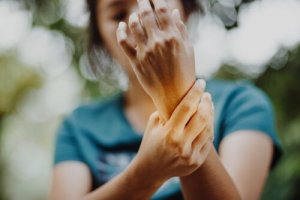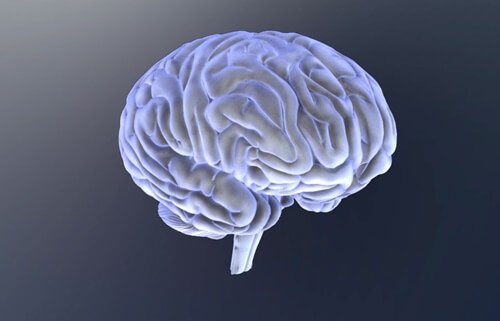Alien Hand Syndrome

Alien hand syndrome (AHS) is an uncommon neurological disorder. However, due to the severe disabilities it causes, it’s a condition we should learn about.
The body experience is a very complicated process. In fact, it involves multiple sensory signals. When there’s a problem with these signals, different neurological disorders can arise, like feeling that an amputated limb is still there or feeling like you have more than two arms or legs.
History of alien hand syndrome
In 1908, Goldstein described the case of a patient who had a stroke on the right side of the brain. After the stroke, the patient claimed that her left leg felt weak and even felt like her left arm didn’t belong to her.
In 1944, Akelaitis described the case of two patients whose corpus callosum had been sectioned in order to treat their epilepsy. One of them claimed that his left hand made involuntary movements, opposite to what he wanted his right hand to do. The doctors named the condition diagnostic dyspraxia.

In 1972, Brion and Jedynak named the condition alien hand syndrome. These authors interpreted the erratic behavior of the left hand as a pathognomonic sign of callosal lesion. They analyzed the behavior of four patients who had many signs of disconnection syndrome. Their symptoms involved:
- Problems naming objects that were outside of the left hand’s field of vision.
- Difficulty making movements with the left hand after a verbal command.
- Constructional apraxia.
- Agraphia on the left hand.
- Hemispatial neglect or attention deficit.
- Difficulty sending sensory information from one hand to the other.
After all their research, they were able to demonstrate that the symptoms of AHS could be associated with several nosological disorders.
Alien hand syndrome
Patients with AHS feel like their limb is moving by itself, that it makes involuntary movements that seem intentional. In fact, these movements often antagonize the opposite limb.
Those affected by this syndrome tend to think their limb isn’t part of their body. It’s like it doesn’t belong to them. In many cases, they’re scared of these involuntary movements and try to focus all their attention on stopping or preventing them.
Sometimes, patients who suffer from alien hand syndrome are able to control themselves voluntarily. Because of this, author Biran and collaborators suggested in 2006 that AHS had three main elements:
- The limb is inhibited and tends to react to rational environmental stimuli, which results in utilization behavior.
- The sequence of the motor fragments in the uncontrolled limb make its movements seem voluntary and controlled.
- There’s a clear awareness of the behavior of the alien limb.
Thus, in stressful situations, AHS may worsen.
Experts also say that:
- Interesting near-by objects may trigger the symptoms.
- The behavior manifests when the patient has low attention levels.
What causes AHS?
You may be asking yourself what causes alien hand syndrome. Surgical procedures, such as corpus callosotomy to treat drug-resistant epilepsy (a procedure that is no longer carried out) and tumor removal, are the culprits.

Types of alien hand syndrome
Frontal AHS
Frontal AHS results in the damage of certain brain areas:
- Supplemental motor area
- Cingulate cortex
- Prefrontal cortex
- Corpus callosum’s anterior part
The medial frontal cortex injury causes alterations in the opposite hand.
Callosal AHS
- It manifests in the same hand of the dominant hemisphere.
- Manifests in patients whose corpus callosum is injured.
- Thus, a nondominant-hemisphere frontal injury can be associated with it, especially the supplementary motor area.
- There can be a conflict between the two hands and apraxia.
In the last decade of the 20th century, several authors defined a new type of AHS: posterior AHS. This variant is less common than the ones mentioned above and is characterized by independent movements and personification of the affected limb.
Treatment
The treatment for this syndrome consists of several techniques:
- Perception and control boost.
- Stress management.
- Compensatory strategies.
A film reference
In 1964, Stanley Kubrick directed a film called Dr. Strangelove that was based on the novel Red Alert by Peter George. The novel tells the story of the attempts of a mad commander to start a nuclear war and how others tried to stop him.
Strangelove is a very extravagant character who experiences strange limb movements. His right hand seems to be alive and, throughout the film, its movements seem involuntary and inappropriate. In fact, the doctor even tries to control these movements with his other hand. Thus, the movie successfully shows what it’s like to live with AHS.
All cited sources were thoroughly reviewed by our team to ensure their quality, reliability, currency, and validity. The bibliography of this article was considered reliable and of academic or scientific accuracy.
-
Hidalgo-Borrajo, R., Belaunzaran-Mendizábal, J., Hernáez-Goñi, P., Tirapu-Ustárroz, J., & Luna-Lario, P. (2009). Síndrome de la mano ajena: revisión de la bibliografía. Revista de neurología, 48(10), 534-539.
-
Giummarra, M. J., Gibson, S. J., Georgiou-Karistianis, N., & Bradshaw, J. L. (2008). Mechanisms underlying embodiment, disembodiment and loss of embodiment. Neuroscience & Biobehavioral Reviews, 32(1), 143-160.
- Brion S, Jedynak CP. Trouble de transfert inter-hémisphérique à-propos
de trois observations de tumeurs du corps calleux: le signe de la
main étrangère. Rev Neurol (Paris) 1972; 126: 257-66. -
Biran, I., Giovannetti, T., Buxbaum, L., & Chatterjee, A. (2006). The alien hand syndrome: What makes the alien hand alien?. Cognitive Neuropsychology, 23(4), 563-582.
-
Giovannetti, T., Buxbaum, L. J., Biran, I., & Chatterjee, A. (2005). Reduced endogenous control in alien hand syndrome: evidence from naturalistic action. Neuropsychologia, 43(1), 75-88.
-
Akelaitis, A. J. (1944). A study of gnosis, praxis and language following section of the corpus callosum and anterior commissure. Journal of Neurosurgery, 1(2), 94-102.
This text is provided for informational purposes only and does not replace consultation with a professional. If in doubt, consult your specialist.








